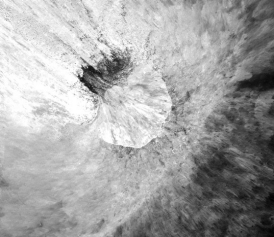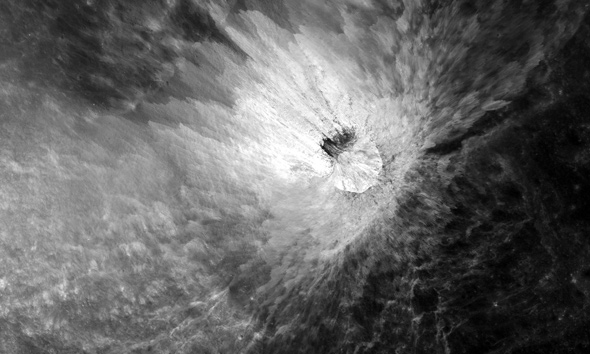Brushstrokes of Impact
Astronomy and art are strongly intertwined.
Perhaps art is just a way we interpret input to our brains; sound as music, light as images, chemistry as taste and smell. I think that may be a bit too reductive, but still, it’s difficult to argue that we must separate art and science when you see pictures like this:
That is a crater on the Moon, shot by the Lunar Reconnaissance Orbiter. It’s roughly 1,000 meters across (0.6 miles) and located near the wall of a much larger crater called Darwin C.
The splashy pattern is, in fact, a splash pattern! When the small asteroid or comet that created this crater slammed into the Moon, a lot of material (called ejecta) was blown out. Material at different depths has different compositions, which is probably why you see the different shades of gray through the ejecta; plumes of material were thrown out and overlaid each other to create that pattern. As formations like this age they change color too (exposure to sunlight and micrometeorite impacts over billions of years can do that), but the crater here is probably young. And by young, I mean tens or hundreds of millions of years old. Things change slowly on the Moon.

Normally, judging from the splash pattern, I’d guess the impactor came in from the lower right. But it turns out this isn’t a flat surface: The darker region running diagonally from the bottom center to the upper right of the image is actually where the inner wall of Darwin C flattens out into the crater floor (the wall is on the right, the floor on the left). So the smaller, unnamed crater is actually on the floor of Darwin C but only a few hundred meters from the wall.
That makes it a bit harder to figure out what’s what. The impact could have been vertical, but the wall of the bigger crater stopped the material from expanding to the right, so it all blew to the upper left. Note that the smaller crater is asymmetric; the rim is sharp on the right, but crumbly and overrun with debris on the left. I wonder … the left side of the small crater is facing the wall and would have caught the debris reflecting off it like the windshield of a car facing into the rain. The right hand side is tilted so that it would catch less of that debris. That’s how it looks to me, at least, and I could be wrong.
I love this sort of thing, the speculating and sleuthing of events from a single picture of an alien world. I’m no expert, but it’s fun, and to be honest I could probably sit and listen for hours to someone explaining all this stuff.
And it doesn’t hurt at all that the pictures are just so overwhelmingly beautiful. This crater was born in violence and sculpted in chaos, but what has remained for countless eons is frozen beauty.


